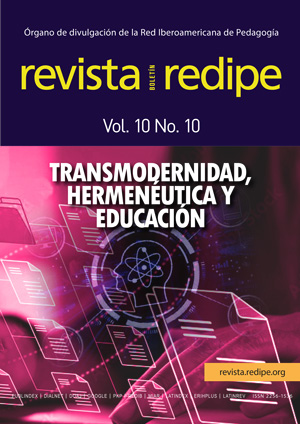El planteo y resolución de problemas desde dominios discretos y profesores de matemáticas en formación
##plugins.themes.bootstrap3.article.main##
Keywords
Planteo de Problemas, Resolución de problemas, Teoría Fundamentada, Dominios Discretos.
Resumen
Este escrito reporta los hallazgos de una investigación con un enfoque cualitativo y un diseño desde la teoría fundamentada, centrado en responder la pregunta, ¿Cómo son las estrategias manifestadas por un grupo de profesores de matemáticas en formación cuando plantean y resuelven problemas desde situaciones en dominios discretos? Como fuentes de datos se diseñaron e implementaron una serie de secuencias de aprendizaje y una entrevista semiestructurada. Los hallazgos muestran como las tareas propuestas en las secuencias de aprendizaje, posibilitaron que cada participante construyera relaciones, hiciera afirmaciones, a partir de esas afirmaciones, generalizara y utilizara ejemplos y contraejemplos como forma de prueba. Se destaca también, la manera como los estudiantes solucionaron los problemas cuando se imponían nuevas exigencias a las soluciones de la ecuación lineal diofántica de la forma ax + by = c y la forma como las utilizaron posteriormente para plantear nuevos problemas y proponer situaciones de la vida real como contextos para formular nuevos problemas. Como resultado se construyó el núcleo de la teoría caracterizado como un flujo de acciones e interacciones entre las estrategias de conjeturar, generalizar, probar y plantear problemas. Finalmente, esto condujo a que el planteo de problemas está inmerso en la resolución de problemas desde el contexto propuesto y que los estudiantes son una buena fuente para plantear problemas.
Referencias
Cai, J., & Hwang, S. (2002). Generalized and generative thinking in US and Chinese students’ mathematical problem solving and problem posing. The Journal of mathematical behavior, 21(4), 401-421.
Cai, J., Chen , T., Li, X., Xu, R., Zhang, S., Hu, Y., . . . Song , N. (2020). Exploring the impact of a problem-posing workshop on elementary school mathematics teachers’ conceptions on problem posing and lesson design. International Journal of Educational Research, 102, 101404.
Cai, J., Hwang, S., Jiang, C., & Silber, S. (2015). Problem-posing research in mathematics education: Some answered and unanswered questions. En Mathematical problem posing (págs. 3-34). New York, NY: Springer.
Cai, J., Jiang, C., Hwang, S., Nie, B., & Hu, D. (2016). How do textbooks incorporate mathematical problem posing? An international comparative study. En Posing and solving mathematical problems (págs. 3-22). Springer.
Charmaz, K. (2006). Constructing grounded theory: A practical guide through qualitative analysis. London: Sage Publications.
Charmaz, K. (2014). Constructing grounded theory (2 ed.). Thousand Oaks, CA: Sage. Corbin, J., & Strauss, A. (2008). Basics of qualitative research:Techniques and procedures for developing grounded theory (3 ed.). Thousand Oaks, CA, USA: SAGE Publications.
Corbin, J., & Strauss, A. (2017). Conceptos básicos de la investigación cualitativa: técnicas y procedimientos para desarrollar la teoría fundamentada (4 ed.). Thousand Oaks, California, United States of America: SAGE Publications.
Ellerton, N., Singer, N., & Cai, J. (2015). Problem Posing in Mathematics: Reflecting on the Past, Energizing the Present, and Foreshadowing the Future. En F. Singer, N. F.
Ellerton, & J. Cai (Edits.), Mathematical Problem Posing. Research in Mathematics Education. New York, NY: Springer. doi:https://doi. org/10.1007/978-1-4614-6258-3_26
Ernest, P. (1997). Chapter 3: The epistemological basis of qualitative research in mathematics education: A postmodern perspective. Journal for Research in Mathematics Education. Monograph, 9, 22-177. doi:10.2307/749945
Felmer, P., Pehkonen, E., & Kilpatrick, J. (2016). Posing and Solving Mathematical Problems. Springer International Publishing. doi:https://doi. org/10.1007/978-3-319-28023-3
Ginsburg, H. (1981). The clinical interview in psychological research on mathematical thinking: Aims, rationales, techniques. For the learning of mathematics, 1(3), 4-11.
Kilpatrick, J. (1987). Problem formulating: Where do good problems come from? En A. Schoenfeld, & A. Schoenfeld (Ed.), Cognitive science and mathematics education (págs. 123-147). Hillsdale, NJ: Lawrence Erlbaum Associates.
Kupisiewicz, C. (1964). O efektívnosti problémového vyučovania: výskum vyučovacích metód matematicko prírodovedných predmetov.
Leung, S. (2016). Mathematical problem posing: A case of elementary school teachers developing tasks and designing instructions in Taiwan. En Posing and solving mathematical problems (págs. 327-344). Cham: Springer.
Mason, J., Burton, L., & Stacey, K. (2010). Thinking Mathematically (2 ed.). Harlow, UK: Pearson Education Limited. Mayer, R. (2010). Problem Solving and Reasoning. International Encyclopedia of Education, 273-278. doi:10.1016/ B978-0-08-044894-7.00487-5
Polya, G. (1945). How To Solve It. Princeton: Princeton University Press. Polya, G. (1981). Mathematical Discovery. New York: Wiley.
Schoenfeld, A. H. (2016). Learning to think mathematically: Problem solving, metacognition, and sense making in mathematics (Reprint). Journal of Education, 196(2), 1- 38. doi:10.1177/002205741619600202
Silver, E. (2013). Problem-posing research in mathematics education: Looking back, looking around, and looking ahead. Educational Studies in Mathematics, 83(1), 157-162.
Von Glasersfeld, E. (2013). Radical constructivism (Vol. 6). Routledge.
Xu, B., Cai, J., Liu, Q., & Hwang, S. (2019). Teachers’ predictions of students’ mathematical thinking related to. International Journal of Educational Research. doi:doi:10.1016/j. ijer.2019.04.005



